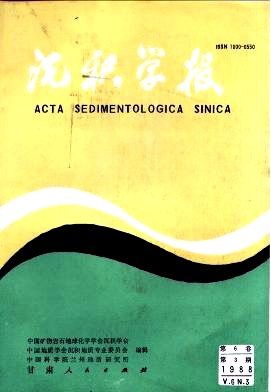GEOCHEMICAL CHARACTERISTICS OF ARGON ISOTOPESOF COAL-FORMED GASES FROM DONGPU DEPRESSIONAND THEIR SOURCE COMPARISON
- Received Date: 1986-07-04
- Publish Date: 1988-09-10
Abstract: Geological setting: Dongpu Depression, located on the banks of the Yellow River at the boundary of Henan Prov. and Hebei Prov., belongs to the mid-southern part of Huabei Basin in the view of reginal tectonics. This depression, with the area of 5300 km2, is a Mesozoicr-Cenozoic grabenlike salt-lake sedimentary basin, dominantly including Paleozoic basement and Cenozoic sediments. Luxi Uplift and Neihuang Uplift respectively-lie each side of the depression. During the Mesozoic-Cenozoic tectonic movement violent faults and depression happened in this area and sediments more than 7000 meters thick deposited in the basin. Among which the Lower-Tertiary sediments are nearly 6000 meters thick and they could be divided upward into two big cycles. These cycles include four rock-salt cyclothems whose total thick-ness is about 1400 meters. The cyclothems change horizontally a lot in facies and are superposedly distributed over 600 km2 in the northern part of the depression, forming ideally regional overlying strataiof oil-gas reservoirs and constituting a good combination of reservoirs and coving strata with lower sandstone strata. In addition, the Upper-Tertiary sediments are a suite of massive sandstone and sandmudstone interbeddings. The thickness is about 1000-1500 meters and geoth-ermal gradient 3.360°C/100m. All of these characteristics indicated that this area is a favourable oil-gas basin. Beneath the Cenozoic sediments, Carboniferous-Permian coal series with the thickness of 800-1100m are widely distributed. Their role, played in secondary gas formation after the burial of Cenozoic sediments and the transportation, is accumulation of industrial gas reservoirs, i.e. the coal-formed gasm has already drawn much attention. Geochemical features of Ar isotopes in natural gases: Based on more than fifty data of Ar isotopes obtained by autnors in this area, the natural gasos in the study area can be divided into three groups according to the variation of Ar40/Ar36 ratios. The ratio of Group I ranges from 331 to 626, averagely 477, Group Ⅱ633-889, aver ragely 757; Group Ⅲ 959-1175, averagely 1087. Comparison of gas resources. Ar in natural gases mainly comesfrom atmospheric air. First, it goesointo sedimentary rocks or underground water during sedimentation and diagen esis. Then it joins in natural gases in the degasing process and becomes one of the micro-components of natural gases. Since Ar is a very stable noble gas, there was no geochemical reaction happened during the process mentioned above. Ar, therefore, keeps no change in quantity and isotopic abound ance, i.e. Ar40/Ar36 = 295.5. In fact, the measured value is often higher than that, sometimes even widely different. The main reason for that is caused by the increase of Ar40 decayed from K40 in potassium minerals contained in adjoin-ing rocks and underground water. Therefore, the older the geological age of adjoining rocks is, the more the rad-ioac tive Ar40is produced and correspondingly the higher the Ar40/Ar86 ratio in natural gases is. Hence it is of certain significance to employ the Ar40/Ar38 ratio as a geochemical index to trace gas strata and gas resources, to estimate gas age, and to identify coal-formed gases. The natural gases incZhongyuan Gasfield has been divided into three types based on the Ar40/Ar36 ratio aboundance. Each type represents a different genesis and is associated with different oil-gas source rocks. The Type I gas has the lowest radioactive Ar40 accumulation compared with the other two types, its average Ar40/Ar36 ratio is about 477. Its source rocks, therefore, might be related to the youngest oil-gas source rocks, i.e.Tertiary Shahejie Group in the depression. The Type Ⅲ gas has the highest radioacsiveAr40accumulation among the three types, its average Ar40/Ar36 ratio is about 1087. So its source rocks might have somthing to do with the Carboniferous-permian coal series which are beneath the Oligocene strata in the depression, namely belonging to a kind of coal-formed gases. The Type Ⅱ gas has an average Ar40/Ar36 ratio which is 75
| Citation: | Li Shushun, Liu Dacheng. GEOCHEMICAL CHARACTERISTICS OF ARGON ISOTOPESOF COAL-FORMED GASES FROM DONGPU DEPRESSIONAND THEIR SOURCE COMPARISON[J]. Acta Sedimentologica Sinica, 1988, 6(3): 112-117. |






 DownLoad:
DownLoad: